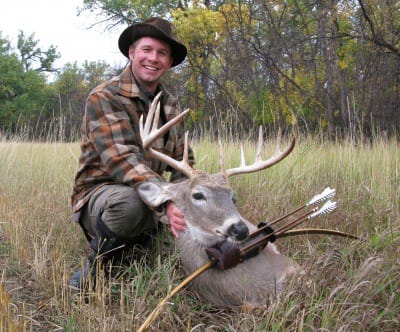
Luke Strommen pulled back his longbow string and launched a wooden arrow down through the cottonwoods. It arched through the air as if in slow motion, then buried to the feathers in the shoulder of a 10-point Montana whitetail. Maybe you saw it on my television show, The Buck Stops Here, on Versus? I truly believe it was the best and most ethical longbow kill ever recorded on a major hunting program.
A lot of viewers did too, because they have been writing Luke and me by the hundreds, saying things like, “That was awesome, man, I wanna do it old-school!”
There is a contingent of modern hunters out there who have shot their share of deer with guns and compound bows, and now they are looking for a different challenge.
“It’s not just different, it’s the ultimate challenge,” says Strommen, who has hunted deer with longbows and recurves all his life out on the Milk River in Montana. “You use all your skills to get within ‘wolf range’ of your quarry, mere yards where a doe or buck instinctively senses danger. Then you have to draw your bow and shoot without the animal seeing you. There’s nothing like the rush of it.”
Gearing Up “Trad”
Strommen suggests a traditional, or “trad,” bow of 60, 62 or 64 inches. “The longer the bow, the more forgiving it is to shoot and learn with,” he says. “I recommend a bow in the 50- to 55-pound range, though you can kill anything in North America with a sub-50-pound bow. Don’t be afraid to buy a 35- to 50-pound bow if that is what you can pull the best. On the other hand, don’t buy a bow with too much weight. It can be tough to draw, and detrimental to your form as you learn to shoot.”
You can spend from $200 for a starter bow to $400 for a good production bow to $2,000 for a high-grade custom job.
“For your first bow, I suggest a Bear, Ben Pearson, Wing or Shakespeare,” says Strommen. “A used bow will suit you just fine. I actually use Ebay for most of my bow purchases for my collection.”
Luke shoots wooden arrows, but he recommends aluminum or heavy carbon shafts for your first recurve or longbow hunts. Be sure the spine of your arrows meets or exceeds your bow’s weight. “It is okay to go 5 pounds or so over on arrow spine, but not under,” says Luke. “If you buy a 50-pound bow, shoot 50 to 55 spine arrows; with a 55-pound bow, 55 to 60 spine and so on.”
A rule of thumb is that your arrow and broadhead should weigh 10 percent of your bow weight. A 50-pound bow, for example, would need a 500-grain or heavier arrow/broadhead combination. “I shoot bows from 50 to 66 pounds, and I use 650- to 800-grain arrows,” notes Luke. “I suggest only fixed-blade or cut-on impact broadheads, 125 grains or heavier.”
Longbow Shooting
The beauty of “trad” is its simplicity. In addition to a wooden bow with a good string and a dozen practice arrows with field points, the only other things you need are a shooting glove, an armguard and a quiver.
You can buy a few block targets to shoot at like compound bow shooters do. Or like Strommen, you can tack small targets onto hay bales and practice like trad shooters have done for decades.
“Either way, it’s all instinctive shooting with no sights,” says Luke. “Bend at the waist, cant your bow a little, learn the sight picture of your arrow in relation to the target, and fire away. The only way to learn is to shoot hundreds and thousands of arrows into the hay from 5 to maybe 20 yards. It’s fun. I enjoy shooting my bows almost as much as I do trying to shoot a deer.”
For more on deer hunting info, go to www.mikehanback.com.



